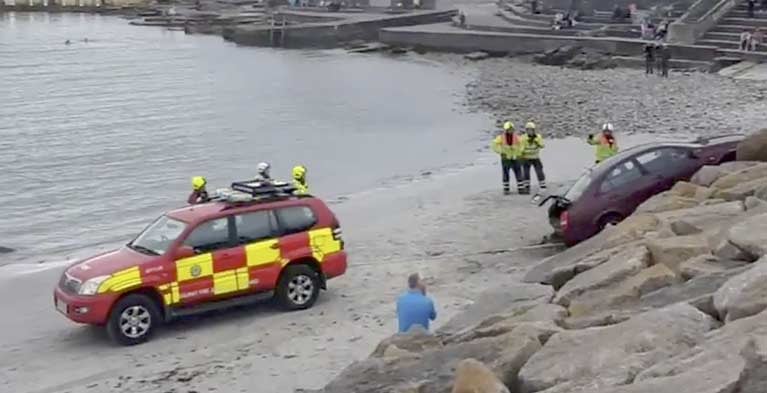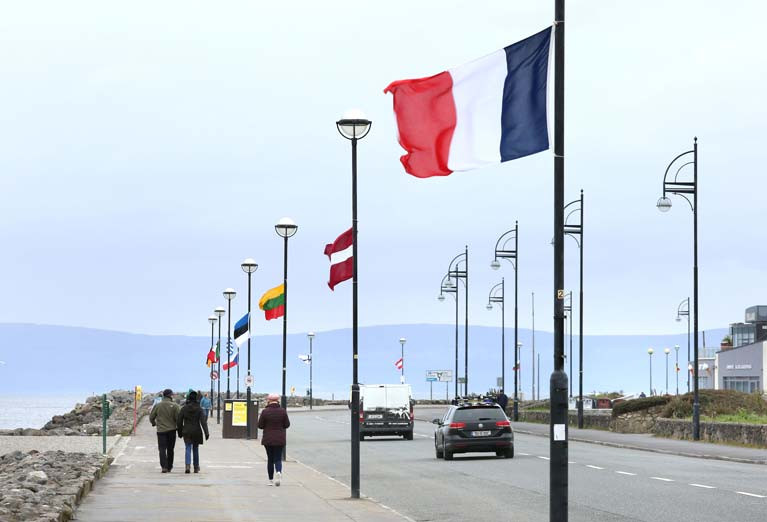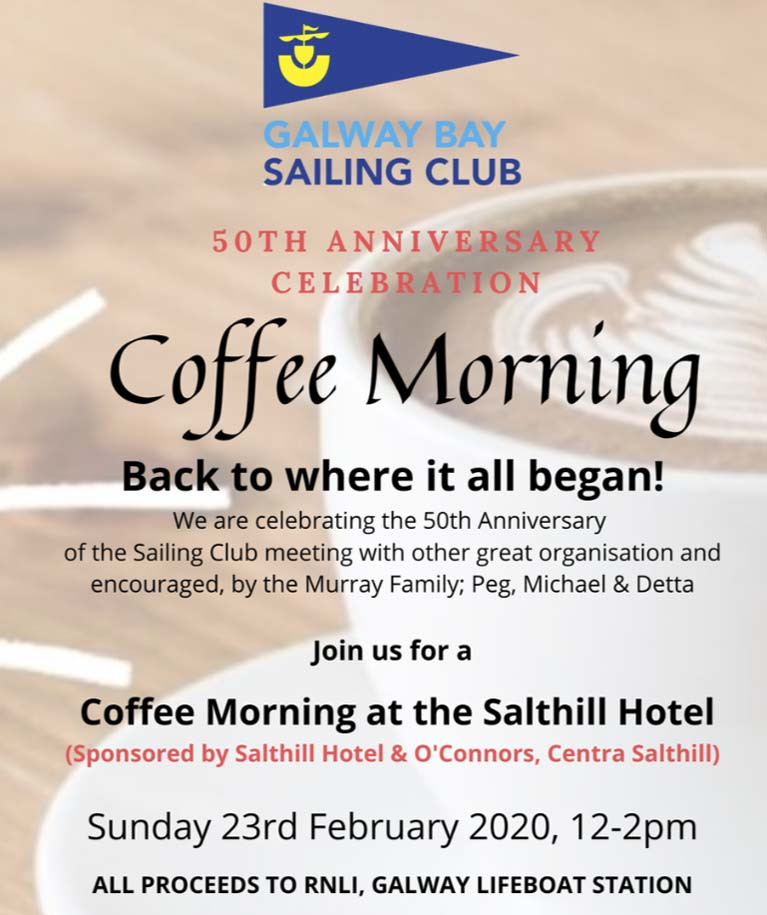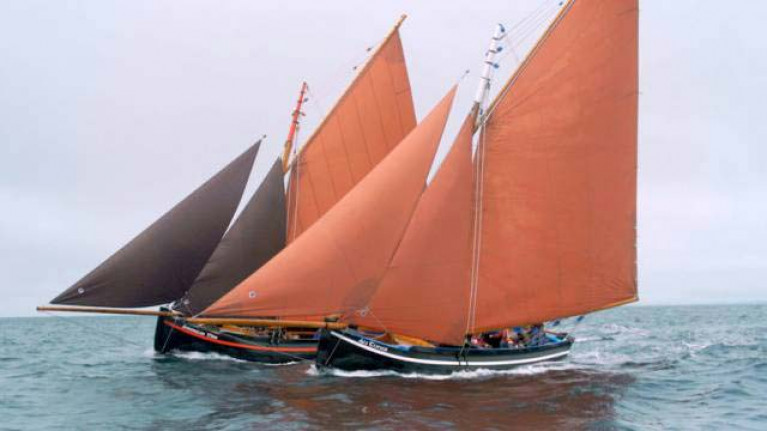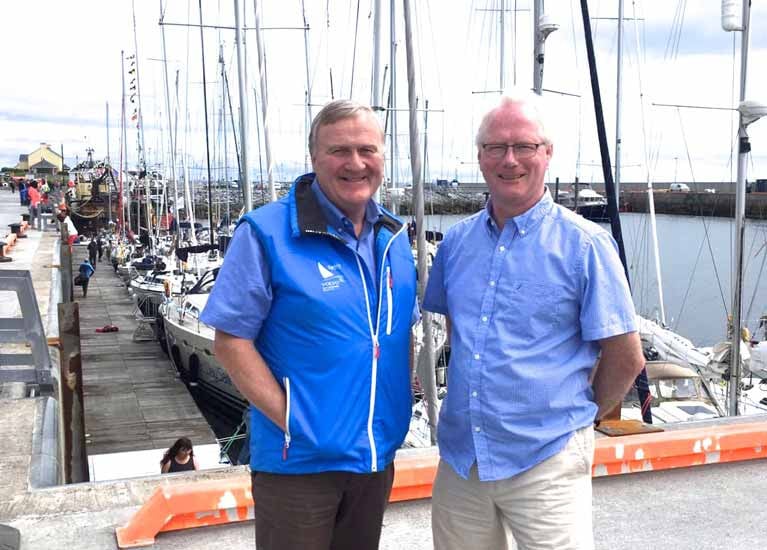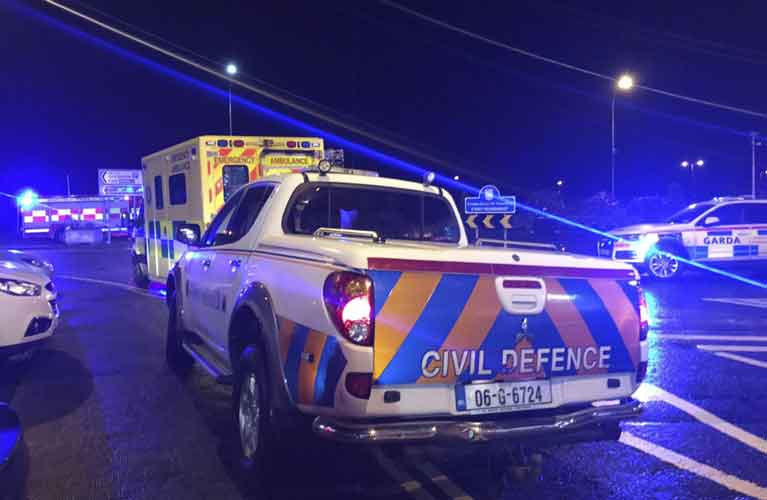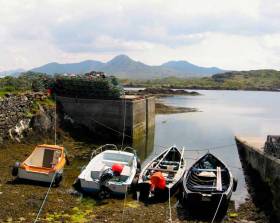Displaying items by tag: Galway Bay
Danú of Galway's Return to Parkmore Pier
When two Galway children set sail with their parents for a circuit of the North Atlantic last summer, little did they know they wouldn’t be homeschooling on their own.
Nor was “pandemic” on the list of potential hazards as Lilian (12) and Ruairí (10) Quinlan-Owens, and their parents Vera and Peter, headed south in heavy winds from Kinvara, Co Galway all of 14 months ago.
Brighter sunshine, a westerly wind and an effervescent welcome greeted the family of four on Monday as they sailed their 13m yacht Danú of Galway into Parkmore several hours before high tide.
To the strains of The Ships are Sailing, played by Josephine Boland and PJ Howell, they threw a line ashore and wiped away a tear or two, in between wide smiles.
Navigating the rain forest on the Maroni river in French Guiana and collecting rock from Dominica island’s famous Boiling Lake in the Caribbean were among highlights recounted by Lilian on deck.
Reaching the Sahara desert before sunrise after a seven-day trek across the Atlas mountains in Morocco, and swimming with sharks, stingrays, eagle rays and other coral reef fish were some of her brother Ruairí’s best memories.
“I did miss my friends, “Lilian said.
When they had to quarantine after the full impact of Covid-19 hit, it was off the small island of Barbuda north of Antigua, where islanders left fresh vegetables and fruit for them on the beach.
They had undergone several quarantines by the time they sailed in yesterday, after a ten-day trip from the Azores north to the Aran islands.
The family had been en route from Guadeloupe in the Caribbean to the island of Montserrat when they heard about Covid-19 lockdowns.
At that stage, Danú had taken them to northern Spain, where they walked in the Picos de Europa mountain range, and to Morocco, where they trekked across the Atlas mountains to ride camels in the Sahara desert.
The couple are both scientists, and Vera is a hydrographer for Infomar, the national seabed mapping programme jointly managed by the Marine Institute and Geological Survey Ireland.
 Vera, Lilian (12), Ruairí (10) and Peter Quinlan-Owens on their arrival into the Aran islands after 14 months in the Atlantic on their yacht, Danú of Galway. The family arrived home to Kinvara on Monday Photo: Vera Quinlan-Owens
Vera, Lilian (12), Ruairí (10) and Peter Quinlan-Owens on their arrival into the Aran islands after 14 months in the Atlantic on their yacht, Danú of Galway. The family arrived home to Kinvara on Monday Photo: Vera Quinlan-Owens
On passage from the Cape Verde Islands to French Guiana last December, they deployed an Argo float which sinks to 2,000m to collects ocean data for climate change research.
The float had already been signed before departure by classmates of Lilian and Ruairí at Kilcolgan Educate Together primary school, some of whom were on hand for yesterday’s (mon) homecoming.
En route home via the Azores, they had to ration their water and ask for a top-up of fuel from a passing tanker.
After leaving that Portuguese archipelago, Danú was almost 400 nautical miles south of the Irish coast when the family had to “hove to” or take down all the sails, secure the tiller and batten down the hatches as they were hit by 35-knot winds.
“We rode out the conditions over ten hours, and were hit by two “growlers” where a huge wall of water swept over Danú, knocking the rails right down under before she came back up,” Vera Quinlan-Owens said.
“The boat was brilliant, but my heart did flutter a bit – thankfully, the kids slept right through it all,” she said.
They hit another system of force six to seven winds when closer to the Aran Islands, making it impossible to navigate the Gregory sound.
Vera’s father, Fergus and his wife Kay Quinlan on their 12m cutter, Pylades and the Minogue family from Kinvara had sailed out to meet them on Inis Mór.
Participating craft in the “Lambs weekend” cruise in company hosted by Galway Bay Sailing Club also celebrated their adventure.
Yesterday’s final leg home under sail was marked by a large banner held by school friends at Parkmore pier, welcoming the “gallant crew”.
After spending much of the past two months on her own in the Atlantic making her way home from the Caribbean via the Azores, the Quinlan-Owens family’s 43ft ketch Danu found her crew being swept up into a socially-controlled welcome home party last in Kilronan. The Galway Bay Sailing Club flotilla co-ordinated by Cormac Mac Donncha in the “Lambs Weekend” cruise-in-company arrived in on a busy programme which had already taken them to Rossaveal and is today (Saturday) taking some on round Slyne Head to Inishbofin, while others will either stay on in Kilronan through Saturday night or else make the passage today to Roundstone, where tomorrow night (Sunday) sees the "Grand Gathering” as the boats return from Bofin.
It’s a programme which will see quite a few collective sea miles being logged along Ireland’s Atlantic seaboard. But meanwhile in Kilronan, where Vera Quinlan and Peter Owens and their family had been relaxing since their post-Azores arrival on Wednesday night with Vera’s father Fergus and his wife Kay on their world-girdling 12m cutter Pylades, and friends Conor and Breda Minogue on their Bownan 40 Golden Harvest, the social pace was allowed to go up a carefully-monitored notch or two in the best Aran Islands style.
 Kilronan this (Saturday) morning. In the foreground is Conor & Breda Minogue’s Bowman 40 Golden Harvest, a Giles-designed Bowman 40 classic of 1974 vintage with which the late Michael Snell of East Ferry on Cork Harbour completed an Atlantic circuit cruise. Photo: Vera Quinlan
Kilronan this (Saturday) morning. In the foreground is Conor & Breda Minogue’s Bowman 40 Golden Harvest, a Giles-designed Bowman 40 classic of 1974 vintage with which the late Michael Snell of East Ferry on Cork Harbour completed an Atlantic circuit cruise. Photo: Vera Quinlan
An elderly couple had a narrow escape when their car left the road and tumbled over rocks towards the sea at Galway’s popular Blackrock diving tower on Wednesday evening.
Emergency services including the Galway Fire and Ambulance Service, Gardai, Irish Coastguard helicopter and RNLI lifeboat volunteers were alerted after the Nissan Almera reversed over the pavement at Salthill promenade and fell about six metres (20 ft) down towards the beach.
The incident occurred at around 5 pm, just an hour after high tide, but the car did not hit the water. Several units of Galway Fire Brigade managed to free the elderly couple from the car on the rock armour.
Car accident in #Salthill pic.twitter.com/lOwzrx0Zki
— Inga Turcan (@Inga_Turcan) June 17, 2020
The Irish Coast Guard helicopter which was en route from Shannon was stood down when it appeared that the vehicle was not in danger of hitting the water.
The couple was taken by ambulance to University Hospital Galway. It is understood that their injuries are not life-threatening.
Sgt Vincent Jennings of Salthill Garda Station said that it was a “miracle” that there were no fatalities or injuries.
“The Prom has been very busy, and this was just an hour after high tide,” Sgt Jennings said. He said onlookers gave several rounds of applause when the couple were stretchered up to the ambulance by paramedic staff.
Labour councillor Niall MacNelis, who was leaving a Galway City Council meeting in Leisureland, Salthill just after the incident happened, paid tribute to the Garda and emergency personnel.
“If it had been a warm summer’s evening, this could have been a very serious incident, and we are all glad that the couple survived,” he said.
Efforts were being made by the fire brigade to remove the vehicle from the rocks. Traffic diversions were put in place for several hours in Galway this evening.
European Flags Fly on Galway's Salthill Promenade
A former Galway mayor has welcomed a move to fly flags of over 20 European countries along Salthill’s promenade.
Labour councillor Niall MacNelis welcomed the initiative as “a gesture of solidarity to European neighbours who are badly affected by the COVID-19 pandemic”.
“Galway is a multicultural city, and while we have asked people to fly Tricolours as a gesture of support for our healthcare workers, we are also aware that there are people of many nationalities living and working here,” he said.
 Flags in Salthill - a gesture of solidarity to European neighbours
Flags in Salthill - a gesture of solidarity to European neighbours
Most, but not all of the EU member states, are represented on the light standards - with the non-EU state, Norway, included, and Britain’s Union Jack excluded.
When Pierce Purcell and others such as the late Dave Fitzgerald and David Whitehead were trying to get Galway Bay Sailing Club into being fifty years ago, they had to deal with the reality that Galway city’s long and varied coastline presented many challenges. Access points of varying quality to recreation afloat included the Claddagh on the River Corrib itself, plus the ships’ dock accessing the Bay by a sea-lock, together with the spacious inland sea of Lough Corrib in the north of the city, dinghy sailing waters in the partially-tidal inlet of Lough Atalia, and several sheltered sea inlets to the east of the city, towards Oranmore at the head of Galway Bay.
In time, GBSC settled on headquarters at Renville, with its sheltered inlet near Oranmore, to create a proper clubhouse/dinghy park/anchorage complex. It’s there that 2020’s Golden Jubilee celebrations will begin on this Friday night (February 21st) with Pierce Purcell presenting a “Reeling in the Year” show (proceeds to the RNLI) about the eventual move ro Renville, where until 1981 they had to make do with a caravan as the main shore base for a growing range of activities.
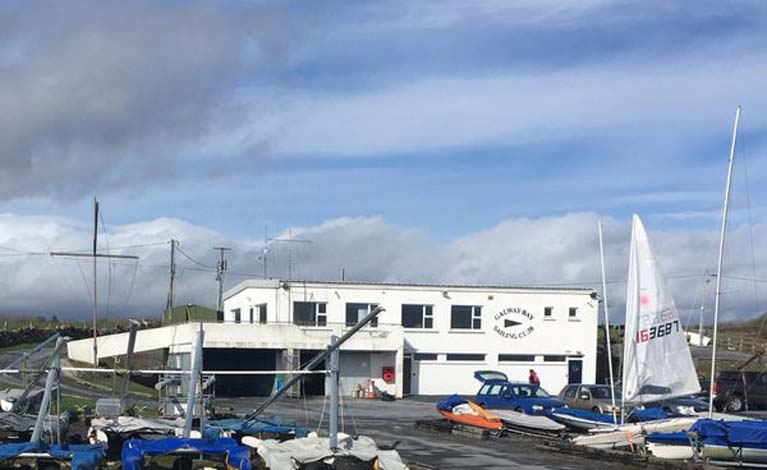 Fifty years down the line, Galway Bay SC now sails from this modern clubhouse at Renville
Fifty years down the line, Galway Bay SC now sails from this modern clubhouse at Renville
However, members still fondly remember those early winter gatherings in the Salthill Hotel to the west of the city, where they diligently built a membership base which was developing as a result of pioneering dinghy sailing events in which they’d tested the usefulness of the various sailing possibilities on the city’s waterfront.
In time, however, the move to Renville became inevitable, as the growing number of keelboats required a 24-hour-accessible anchorage. But many senior GBSC members have the fondest memory of those early gatherings at the Salthill Hotel, so it’s there on Sunday (February 23rd) that a Golden Jubilee Coffee Morning will get going at noon, and if it phases into a convivial nautically-themed shared viewing of the Ireland-England Rugby Match, so be it….
Galway 2020 Opening Ceremony "under review" Due to Weather
Galway 2020 has said it is keeping the weather situation “under review” for its opening ceremony this evening writes Lorna Siggins
Met Éireann has upgraded its weather warning status from yellow to orange for Galway on Saturday, with heavy rainfall and south to south-west winds reaching mean speeds of 65 to 80 km per hour, with gusts of up to 120 km per hour.
An estimated 20,000 to 40,000 people are expected to attend the open-air event in the Claddagh South Park on Saturday evening, hosted by British company Wonder Works.
Live music, pyrotechnics and seven giant glowing orbs representing county and city communities are promised during the ceremony, and a fleet of Galway hookers was due to set sail – but this may have to be curtailed due to the weather forecast.
President Michael D Higgins is due to declare the year-long European capital of culture open just after 6 pm.
Galway 2020 has said that it is “aware of the current weather advisories”.
“As public safety is our primary concern, we are keeping the situation under review,” it said in a statement on Friday evening.
“ Our intention is that the event will still go ahead, but may be subject to alteration. We will update further on Saturday morning,” it said
Met Éireann said that Galway City Council is monitoring the current forecasts with it, and has “adjusted the event programme to take account of the forecast weather conditions and to ensure public safety during the event”.
The event license for the opening ceremony extends to Sunday, but Storm Ciara will be sweeping over the country and wind conditions are expected to be more severe.
A new work by celebrated Irish language poet Louis de Paor is due to be premiéred, with the voices of Olwen Fouére, Bríd Ní Neachtain, Stephen Rea, Naisrín Elsafty and Caitlín Ní Chualáin.
Event hosts Wonder Works, veterans of the 2012 and 2016 Olympic games in London and Rio de Janeiro, have billed it as a “large scale dramatic explosion of sound and vision”.
Bad Weather in All Its Glory The Focus of Galway 2020 Street Mural
Bad Irish weather and why we should all embrace it is the theme of Galway 2020 European Capital of Culture’s first street mural.
The mural was unveiled in Galway city centre by TG weather presenter Caitlín Nic Aoidh for the Hope it Rains/Soineann nó Doineann project yesterday.
Galway-based artist Shane O’Malley has used hydro-chromic paint for an abstract image, the shape, size, geometric patterns, and colours of which change in reaction to rainfall.
The direction, intensity and amount of rain determine which version of the mural is visible, making it as changeable as the weather, artistic director and curator Ríonach Ní Néill explained.
Located on the corner of Church Lane and Shop Street, the mural named “Changes change” is a “visual barometer for pedestrians of patterns of rainfall and drought”, the project says.
Galway 2020 creative director Helen Marriage said the programme has been “built around the central themes of landscape, language and migration, and Hope it Rains | Soineann nó Doineann will work with local artists to address a constant of the Galway landscape”.
Ní Néill said her project is “challenging artists to create works that directly interact with and respond to the weather, and use it as a source of creativity.
“The project fosters a thoughtful approach which seeks the advantages of our mild, windy and wet weather, all the while building awareness of the need for immediate action to mitigate climate change,” she said.
Cormac MacDonncha of Galway is December Sailor of the Month (Leadership in Sailing)
At year’s end, the Sailors of the Month adjudicators survey the overall scene in search of an outstanding and innovative event which has added to the variety of the Irish sailing programme. In 2019 this role was well filled by the Galway-Lorient Cruise-in-Company organised in July with great energy, enthusiasm and effectiveness by Cormac Mac Donncha. It attracted 27 boats including a French contingent, together with participants from as far north as Sligo on Ireland’s Atlantic seaboard, and set new levels of target achievement which similar future events will do well to match.
Galway’s Harbourmaster Hits Out at Lack of Storm Warning
Galway’s harbourmaster has hit out at the lack of warning for a severe storm which caused flooding in parts of the city and Salthill last night writes Lorna Siggins.
The city’s emergency plan was invoked after southerly winds forecast at 40 to 45 knots hit 73 knots, and there was a sea surge over quays in the docks and in Salthill.
A cargo ship making regular deliveries to the Aran Islands was thrown up on rock armour when it broke one of its moorings. The 39-metre Saoirse na Mara sustained considerable damage during the height of the winds at around 8 pm.
Capt Sheridan said Valentia Coast Guard had been informed last night, and there was no pollution from the ship and no injuries to crew. Efforts would be made to refloat the vessel at high tide this morning, he said.
Capt Sheridan said the city had “only dodged a bullet by a miracle”, but said he was furious at the lack of warning.
“With climate change and sea-level rise, we are only going to have more of these events and we need to be prepared,” he said.
“This inaccuracy of forecasting highlights our lack of ocean literacy and our need to focus on understanding what is actually going on in the ocean,” he said.
“We need to remind ourselves that the planet is 70 per cent water, and the ocean controls so much of our daily lives. Climate change is here and now,” Capt Sheridan emphasised.
The port had hosted an emergency training exercise for staff yesterday afternoon, and so Capt Sheridan said he had been particularly vigilant about weather forecasts.
“That exercise went off well, but at 3 pm it was forecast for 40 to 45-knot winds on Wednesday night. It reached 73 knots and was off the scale.”
The gusts caused widespread damage to trees on routes in and out of the city.
Galway Sailors Will Give Their Own Connemara the Visitor Treatment
One of the great successes of the 2019 season was the Galway-Lorient Cruise-in-Company in July to celebrate the ancient seaborn links between the City of the Tribes and the historic port and Celtic centre of South Brittany on France's Biscay coast writes W M Nixon
Put together in precise detail by serial organiser Cormac MacDonncha of Galway Bay SC, it attracted an impressive fleet of 27 boats drawn mostly from Ireland's Atlantic seaboard, but also including the key ingredient of three fine boats which had come over from Brittany.
They were led by Lorient YC President Jean-Gab (Jean-Gabriel) Samzun with his handsome Peterson 46 Trilogy, which once upon a time was Robin Aisher's Yeoman XXI, a finisher in the storm-battered 1979 Fastnet Race with the crew including the owner's daughter Sally, who these days is Mrs O'Leary of Crosshaven.
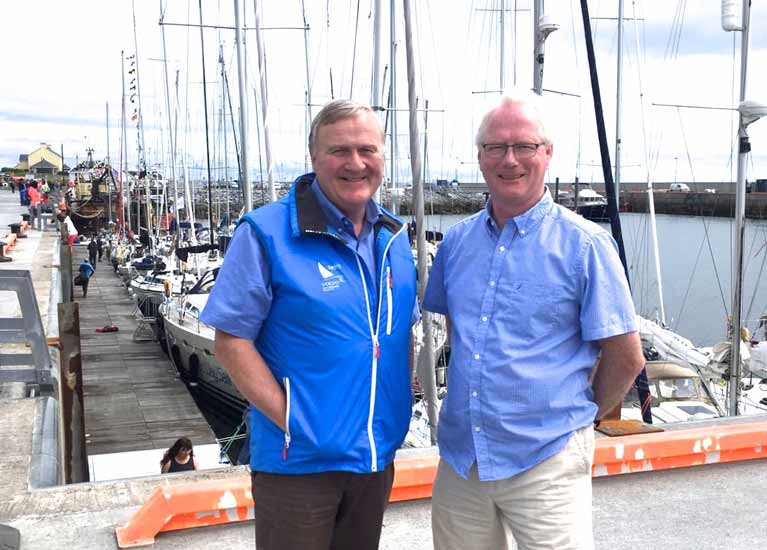 Irish Sailing President Jack Roy with "serial organiser" Cormac Mac Donncha at Kilronan in the Aran Islands when the latter made it the venue for the WIORA Championship in 2017.
Irish Sailing President Jack Roy with "serial organiser" Cormac Mac Donncha at Kilronan in the Aran Islands when the latter made it the venue for the WIORA Championship in 2017.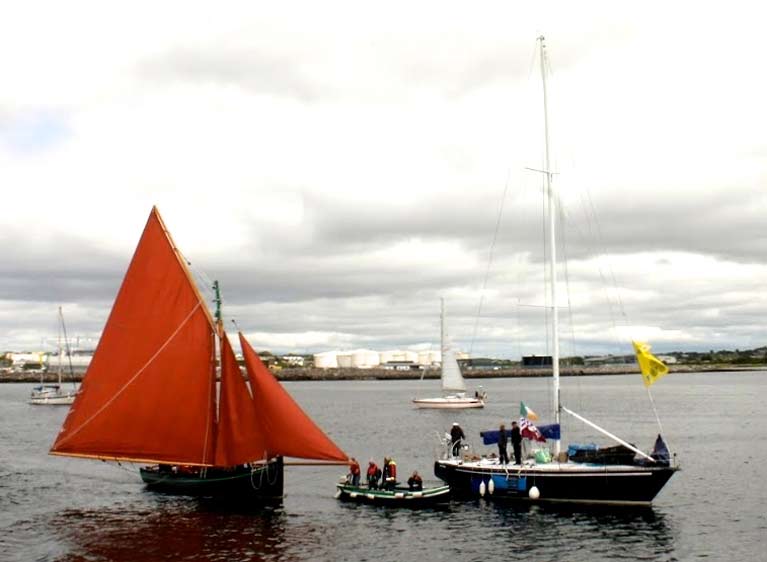 Peter Connolly's City-built Galway Hooker with Jean-Gab Samzun's Peterson 46 Trilogy (ex-Yeoman XXI) off Galway port before the start of the Galway-Lorient Cruise-in-Company
Peter Connolly's City-built Galway Hooker with Jean-Gab Samzun's Peterson 46 Trilogy (ex-Yeoman XXI) off Galway port before the start of the Galway-Lorient Cruise-in-Company
The Lorient sailors are so enamoured of Connacht that they're returning in a reciprocal visit to Galway port in June of next year. But meanwhile the Galway and West Coast sailors - having successfully taken on the intricate waters of west and south Brittany in 2019 - have decided that later in 2020 they should make a point of some detailed navigation and pilotage in the cruising paradise which is on their doorstep, and much cherished by visiting cruising boats – particularly those from France.
Because of course, that's the problem with being based in Galway. The wondrously intricate and mysterious coast of Connemara – "The Land of the Sea" – is only about twenty miles to the westward. Getting there isn't thought of as any big deal by Galway sailors. Yet such is the place's enchantment that sailors from all over Europe and further afield will voyage for many miles just to savour the joys of this unique coastline, which has rightly been described as more of a personality than place.
So the latest Mac Donncha project is a detailed August Bank Holiday weekend cruise-in-company for West Coast sailors in the hope of experiencing the Connemara coast as visitors see it. They'll be busy in the city in June with the hospitality for the boats from France, but by July the seemingly continuous city Festival Season is underway, and it gets beyond all reason at the end of the month with the Galway Races.
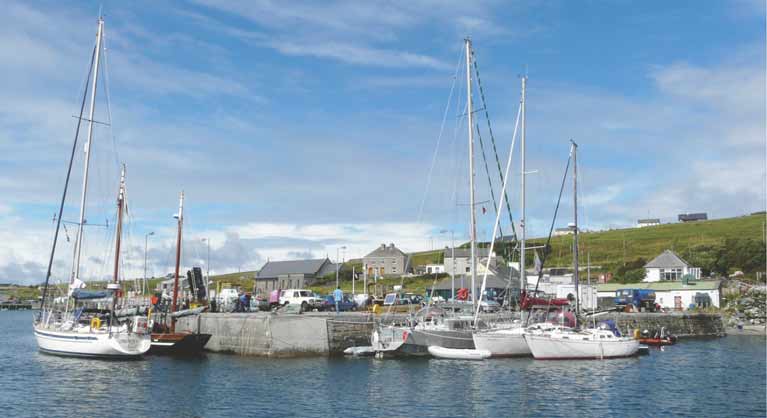 High water for an intriguing selection of cruisers at the quay at Inishbofin, a destination for next year's GBSC long weekend cruise-in-company. Photo ICC.
High water for an intriguing selection of cruisers at the quay at Inishbofin, a destination for next year's GBSC long weekend cruise-in-company. Photo ICC.
That is when it's reckoned the GBSC cruising sailors and their friends from up and down the west coast can be reasonably excused for being out of Galway City and in Connemara and places adjacent, so the programme being mapped out is:
- Thursday, July 30th: Depart Galway Docks for Rosamhil (Rossaveal) Marina.
- Friday, July 31st: Rosamhil to Kilronan (Aran Islands)
- Saturday, August 1st: Kilronan to Inishbofin
- Sunday, August 2nd: Inishbofin to Roundstone
- Monday, August 3rd (Bank Holiday) Roundstone to Rosamhil.
- Monday, August 3rd Cruise-in-Company concludes at Rosamihil.
Those who know the coast of Connemara will realise that the passages from Galway Bay to and from Inishbofin involve negotiating Slyne Head, and for the more quirky cruising brethren and sisterhood, negotiating Slyne Head means contemplating the use of the inner passage through the narrow gap known either as the Joyce Sound or Joyce's Pass, or indeed the Joyce Sound Pass.
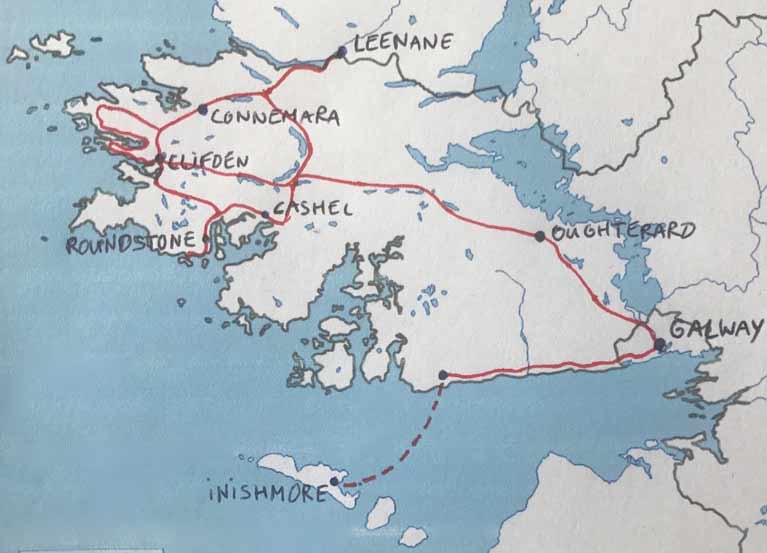 An intriguing pilotage and navigational challenge – the Connemara coastline between the Aran Islands (bottom) and Inishbofin (top left)
An intriguing pilotage and navigational challenge – the Connemara coastline between the Aran Islands (bottom) and Inishbofin (top left)
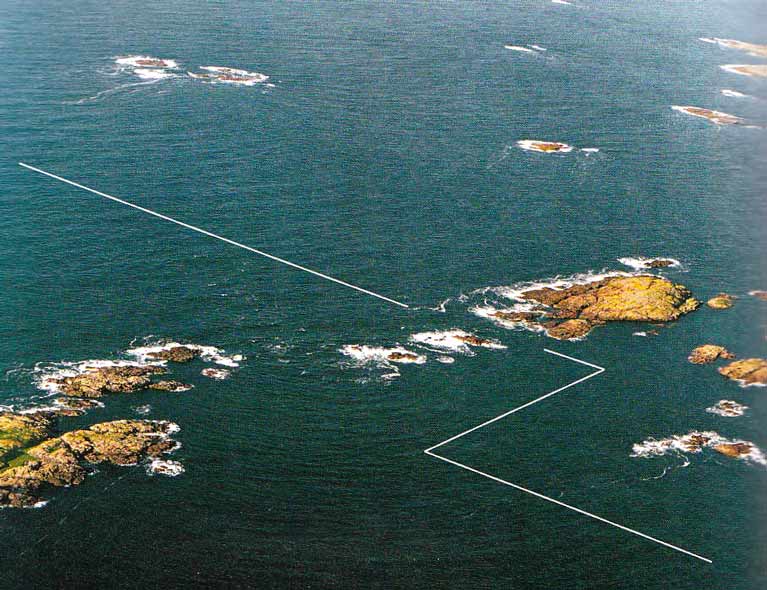 The Joyce Sound Pass is a useful short-cut inside Slyne Head, but complete information is needed for a safe passage through. Photo ICC
The Joyce Sound Pass is a useful short-cut inside Slyne Head, but complete information is needed for a safe passage through. Photo ICC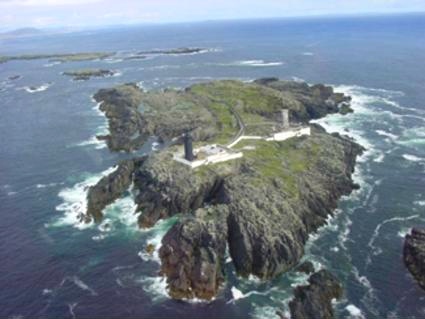 Slyne Head is the most seaward of a line of rocky islands.
Slyne Head is the most seaward of a line of rocky islands.
Whatever name you choose for this tricky channel, it can be something of a challenge. But the rewards in distance saved and the avoidance of the often lumpy seas off Slyne Head make it an attractive proposition, though a careful reading of the Irish Cruising Club directions as compiled by Honorary Editor Norman Kean shows that this is not a short-cut to be trifled with.
But whatever way you go in negotiating Slyne Head, this is a wonderful away-from-it-all area, a true holiday coast. As ever, the Galway hospitality goes the extra distance – the word is that if you don't see yourself having the time to get involved with your own boat, the GBSC welcome machine will try to facilitate you with a berth on a locally-based boat.
And as a taster of what being with the Galway fleet can offer, here's the vid from the summer's cruise to Lorient.





























